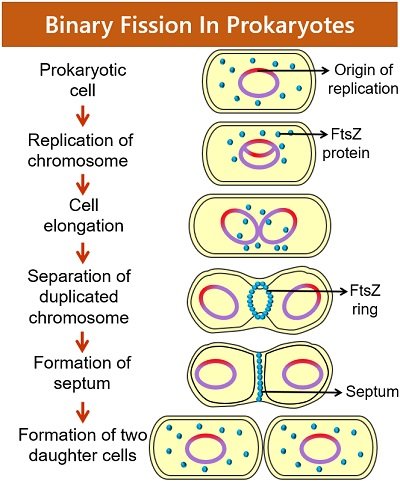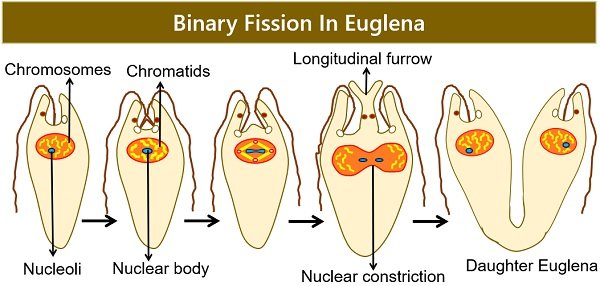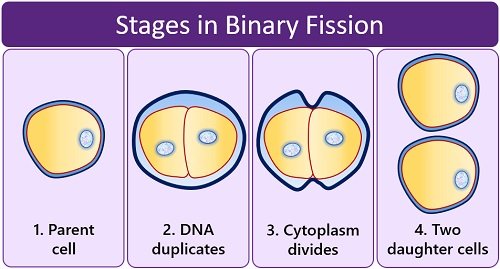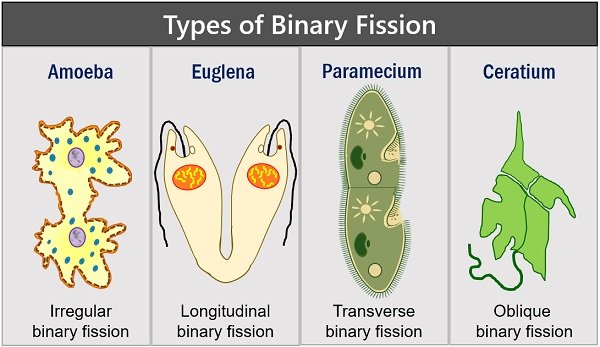Binary fission is an asexual method of cell reproduction. The word asexual implies a reproduction that does not involve sex cells or gametes. Instead, the somatic cells take part in the asexual process that forms a clone of the parent.
Fission is a process in which an organism divides into two or more fragments. Further, the fragments regenerate into new offspring that are genetically alike.
Also, the new individuals have the potential to grow up to the size of a parent cell. By breaking the term binary fission, we can define the term easily. The term binary is marked by a number two, and fission is the splitting or breaking up of something into parts.
So, we can say that binary fission is the process of cell splitting into two daughter cells. Here, an important thing to note is that these daughter cells are genetic clones of a parent cell.
The process of binary fission prevalently occurs in prokaryotes (bacteria and archaea), single-celled eukaryotes (protozoans) and some eukaryotic cell organelles (mitochondria).
This post describes the meaning, steps and types of binary fission. Also, you will get to know the process of binary fission in different organisms.
Content: Types of Binary Fission
Binary Fission Definition
It is a cell-reproduction method that duplicates the parent cell into two identical offspring or daughter cells. Binary fission is one of the asexual reproduction methods. It shares some common features with the mitosis (an asexual method that occurs in eukaryotes) like:
- Both are the types of asexual methods.
- In both cases, chromosomes are copied and separated.
- The cell divides its cytoplasm to form two new cells.
But, the mechanism of the two processes is relatively different.
- First thing, prokaryotes do not undergo karyokinesis, which means they cannot form a mitotic spindle. But, the cells undergoing mitosis form mitotic spindles, which orchestrate the DNA movement.
- Then, the DNA separation co-occurs with DNA replication during binary fission in prokaryotes. In contrast, DNA replication in mitosis occurs during the S-phase, long before its separation in the M-phase.
Generalized Steps
Binary fission is common in prokaryotes like bacteria, archaea and eubacteria etc. and includes the following steps:
- First, the parent cell duplicates its DNA from the origin of replication.
- Then, the cell elongates, and the DNA is copied.
- A septum begins to form between the cell, which constricts the cell into two. Later, the exchange of cytoplasmic material occurs between the separating cells.
- Once a septum forms completely, the cell splits into two identical daughter cells.
Key Facts
- Offspring produced by binary fission are genetic clones of their parents.
- Besides prokaryotes, some simple eukaryotes and eukaryotic cell organelles may also undergo binary fission.
- Binary fission occurs to increase the population of organisms.
- It does not give any genetic variability to offspring, as they are identical.
- It always starts with DNA replication.
- Using binary fission, the cell can divide irregularly, transversely, longitudinally and obliquely.
Types of Binary Fission
- Irregular: It occurs in amoebae having irregular symmetry. The plane of cell division is variable, or it occurs along any axis. But, it always happens at right angles to the expanding nucleus.
- Longitudinal: It occurs in flagellates (like Euglena) and ciliates (like Vorticella). Here, the cell division occurs along a vertical axis that divides a cell’s nucleus and cytoplasm longitudinally.
- Transverse: It commonly occurs in ciliates like Paramecium. Here, the cell division occurs at a horizontal axis.
- Oblique: It occurs in dinoflagellates like Ceratium. In this type, the cell division along a diagonal.
Examples of Binary Fission
While it’s easy to generalize and say binary fission only occurs in prokaryotes, this isn’t exactly true. Specific organelles in eukaryotic cells, such as mitochondria, also divide by fission.

In Prokaryotes
The cell division in prokaryotes is very simple, as their genome comprises a single, circular DNA chromosome. The genetic material of prokaryotes exists within a nucleoid of a cell.
- First, circular DNA chromosome replication begins at the origin of replication. It continues in both directions at once, resulting in the formation of two replication forks.
- Then, the cell lengthens or elongates. The FtsZ proteins migrate toward the midpoint of the cell. The origins move apart and separate the chromosomes as the replication continues.
- Later, the duplicated chromosomes separate and move apart toward the cell’s corners. A concentric ring of FtsZ proteins forms around the periphery of the midpoint between the chromosomes.
- Then, the FtsZ ring initiates the septum formation. Contents of the plasma membrane and cell wall accumulate around the ring. Later, cytokinesis pulls the cytoplasm toward the chromosomes. The division of cytoplasmic contents is necessary to give both new cells the machinery to sustain life.
- Once the septum forms completely, the cell pinches off into two daughter cells. A septum separates the cell’s cytoplasm equally between the two daughter cells. Again, the FtsZ is dispersed throughout the cytoplasm of the new cells.

In Protozoans
It also occurs in simple eukaryotic organisms like amoebas, euglena, and paramecia.
Amoeba
- Amoeba again forms the pseudopodia, and its body becomes round.
- Then, amitosis occurs which involves the division of the nucleus, followed by a splitting of the cytoplasm.
- At the midpoint of the cell, a constriction starts to develop.
- Eventually, a constriction or furrow deepens at the cell’s midpoint, resulting in the formation of two daughter cells.

Paramecium
Binary fission in Paramecium occurs during the favourable condition when food is available in large quantities and the temperature is favourable. The generalized steps in the reproduction of Paramecia include:
- First, the Paramecium stops feeding before it starts replicating its DNA.
- Then, the oral groove gradually disappears. The micronucleus undergoes mitosis and forms the mitotic spindle. In contrast, the macronucleus changes its shape or expands via amitosis cell division.
- Eventually, micronucleus and macronucleus split into two daughter micronuclei and macronuclei. New oral grooves appear as the cell elongates and moves towards the opposite end.
- Then, the constriction develops simultaneously towards the midpoint of the cell body. It results in the division of cytoplasm into two equal halves.
- Thus, the endoplasm splits into two daughter paramecia from the middle of the cell by the transverse cell division.
- Proter is an anterior portion.
- Opishte is the posterior portion.
The proter and opisthe portions resemble the parent cell in size, shape, and structure. In this way, the whole process completes by forming two daughter-Paramecia. All such individuals produced from one parent paramecium are also known as clones, as they are genetically alike.

More to know
- Binary fission in Paramecium usually takes two hours to complete.
- In a day paramecia can undergo binary fission up 1-4 times a day.
- Paramecia can produce about 600 generations in a year through binary fission.
- The rate of multiplication depends upon:
- External factors include food availability, temperature, age of the cell, and population density.
- Internal factors include cell heredity and physiology.
Euglena
Euglena undergoes cell division via longitudinal binary fission. Here, the two daughter-euglena look like mirror images. Thus, the type of cell division that Euglena undergo is known as symmetrogenic division. When they undergo binary fission, the nucleus, basal granules, chromatophores, and cytoplasm of the cell also divide.
- First, the nucleus divides to form two daughter nuclei through mitosis.
- Later, the kinetosomes and the chromatophores also divide.
- As the fission continues, a longitudinal groove develops from the anterior end to the midpoint of the cell body.
- Then, the longitudinal groove continues to extend towards the posterior end.
- Eventually, the cell splits into two daughter euglena.

More to know
- After binary fission, one daughter Euglena has the parental flagellum. In contrast, the other daughter cell develops a new flagellum from the newly formed basal granules.
- A Euglena produces a new stigma, paraflagellar body and contractile vacuole in both the daughter euglena through binary fission.
In Eukaryotic Organelles
Mitochondria and chloroplast are cell organelles that are not produced de novo by the eukaryotic cell. They proliferate by the binary fission of the pre-existing organelle.
Mitochondria are the energy-producing organelles and chloroplasts develop the photosynthetic machinery. Both have their own circular DNA and contain 70S ribosomes.
The cell division in both occur via ring formation at the constriction site. The plastid-dividing (PD) and the mitochondrion-dividing (MD) rings comprise ring-shaped bundles of nanofilaments. These rings exist on the cytosolic side of the outer membrane of the corresponding organelle.
Let us discuss the mechanism of binary fission in Mitochondria.
- The replication of DNA occurs prior to the fission of mitochondria.
- Then, fission proteins Fis1, Mff, Mid49, and Mid51 localize towards the site of division on the mitochondrion. After that, the fission proteins recruit Drp1 to the target site.
- Drp1 (along with the Fis1, Mff, Mid49, and Mid51 proteins) creates a depression on the fission site. It results in pinching off of a mitochondrial membrane.
- The depression along the mitochondrial membrane increases until the pinched areas fuse completely. It causes the mitochondrion to divide into two mitochondria.
Advantages
- It’s a rapid process that reproduces organisms within a short duration.
- The process requires only one parent.
Disadvantages
- Unlike meiosis, the exchange of chromosomal segments does not occur in binary fission, leading to a low degree of genetic variation.
- The genetic variation in daughter cells can be introduced only by inducing mutation (natural, physical or chemical).
- Due to low genetic variability, the organisms produced from binary fission could not resist the changes in the environment or have low survival chances.
Conclusion
Therefore, binary fission is an asexual mode of reproduction which occurs in prokaryotes and some simple eukaryotes. It only requires a single parent cell that divides to give two identical offspring. The newly produced offspring are clones of the parent cell, due to which they are genetically invariable.



I reviewed your blog it’s really good. thanks a lot for the information about this blog.